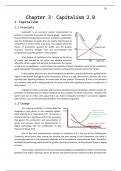36
Chapter 3: Capitalism 2.0
1 Capitalism
1.1 Principle
Capitalism is an economic system characterized by
private or corporate ownership of capital goods, investments
that are determined by private decision, and prices, production,
and the distribution of goods that are mainly determined by
competition in a free market. In essence, it's a system where the
means of production operate for profit, and the greater
economic structure emerges from the accumulation and
reinvestment of profits gained in a free market.
A key feature of capitalism is the reliance on the forces
of supply and demand to set prices and allocate resources
efficiently. When supply and demand are balanced, the market
is said to be in equilibrium: a point where the quantity of goods supplied is equal to the quantity of
goods demanded. This balance determines the price and quantity of goods sold in the market.
In this system, the decisions about investment, production, and distribution are guided by the
signals in the market through the price mechanism. If there is a high demand for a product, the price
typically rises, signaling producers to create more of that product. Conversely, if there is less demand
for a product than what is being produced, the price usually falls, signaling producers to make less of
that product.
Capitalism is often associated with economic growth because it provides a strong incentive for
producers to develop new and better products as they compete to attract consumers. However, the
system also has its critics, who argue that it can lead to inequality and that it can lead to negative
externalities, such as environmental pollution, if not properly regulated.
1.2 Change
The ongoing evolution of technology has
instigated a new phase in the capitalist system,
often referred to as "Capitalism 2.0". This phase is
characterized by a significant shift in the principles
that govern the production and consumption of
goods and services, driven by advancements in
digital technology and the proliferation of the
Internet of Things (IoT).
One of the most transformative concepts in Capitalism 2.0 is the rise of the Collaborative
Commons, which posits that sharing has become the new owning. In this framework, the value is
increasingly seen not in the possession of goods, but in the ability to access and use them. This shift is
facilitated by technology, which allows for greater sharing of resources, be they physical items or digital
services.
The IoT plays a critical role in this new capitalist paradigm by enabling the creation of interactive
platforms that foster a sharing culture. As devices and systems become interconnected, they generate
, 37
and exchange data, which can be leveraged to create more efficient and responsive services that meet
the real-time needs of users.
A remarkable consequence of these technological advances is the reduction of marginal costs
toward zero, particularly for digital goods. As production scales up, the cost of producing an additional
unit (the marginal cost) often diminishes, sometimes approaching zero for digital products. This makes
it possible for certain goods and services to appear almost free, which fundamentally alters traditional
economic models that are based on scarcity and ownership.
The emergence of the IoT signifies an era where everything is connected, forming a vast
network of data that can be analyzed and utilized in unprecedented ways. This connectivity not only
enables new business models but also demands a rethinking of strategies to capitalize on the vast
opportunities presented by this interconnectedness.
Example: Netflix
Netflix revolutionized the entertainment industry by introducing a subscription-based model
for accessing movies and TV shows over the internet. This approach diverged from the physical rental
and sale of media, significantly reducing distribution costs.
The success of this model showcases a transformative shift where access and user experience
take precedence over ownership. Their platform employs algorithms to tailor content
recommendations to individual preferences, fostering a personalized viewing experience. This strategy
aligns with the broader digital market trend where the marginal cost of distributing digital content is
minimal, enabling a cost-effective and scalable business model.
Such innovative approaches highlight the shift towards what's been termed "Capitalism 2.0,"
reflecting a new paradigm where sharing and collective access reshape consumer behavior and
business strategies. This transition is indicative of the larger movement towards a collaborative, data-
driven economy that leverages technology to provide services that appear cost-effective to the end-
user.
2 Consumers
In the emergent landscape of Capitalism 2.0, interconnected consumers are at the heart of
economic transformation. This shift is propelled by the emergence of new consumer demographics and
profound technological innovations. Today's consumers are not passive end-users but are integral to
the value creation process, thanks to the proliferation of digital platforms that allow for unprecedented
levels of communication, collaboration, and co-creation. They leverage technology to assert their
influence, with new consumers, especially millennials and Gen Z, displaying distinctive preferences that
favor access over ownership, customization over uniformity, and community-driven experiences.
Companies that recognize and harness these forces by engaging with these tech-savvy consumers and
integrating their input into product development and service delivery are carving out competitive
advantages in a rapidly evolving market.




